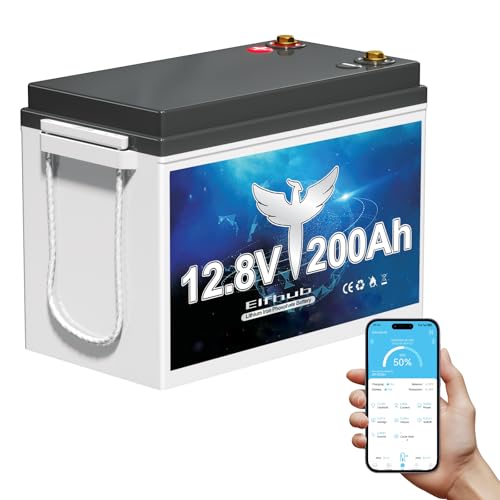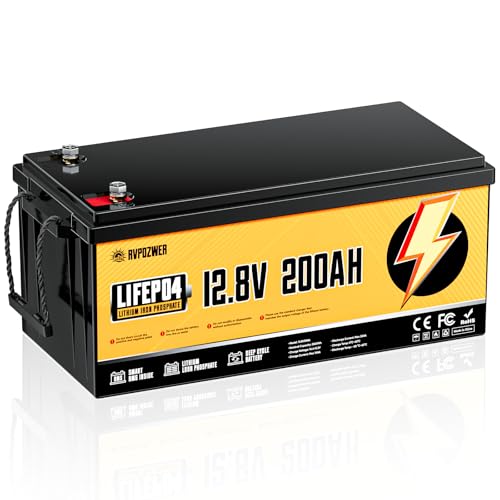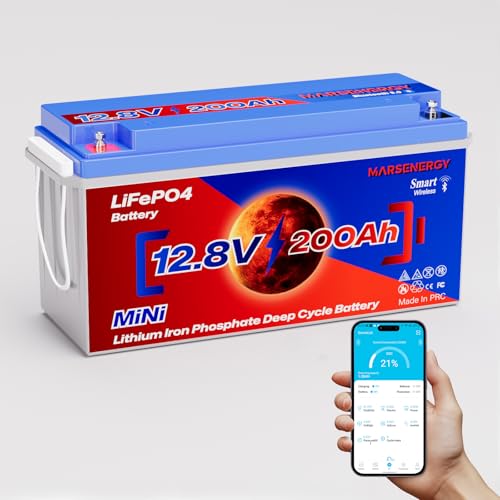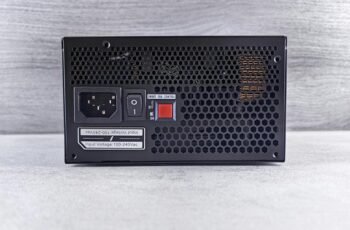If we’re upgrading power for an RV, cabin, or boat, a 200Ah LiFePO4 battery can be a smart move—lighter, safer, and far longer-lasting than lead-acid. This year’s top picks pack 200A BMS protection, smart Bluetooth monitoring, and scalable setups to 24V/48V or 800Ah. We’ll compare real capacities, low-temp performance, charge rates, and warranties, plus where each shines. Let’s start with the standouts—and a few pitfalls to avoid.
Key Takeaways
- Prioritize 12V 200Ah LiFePO4 with 200A BMS, offering 2560Wh, fast charging, and protections against over/under-voltage, over-current, and short-circuit.
- Look for expandable systems: series to 51.2V and parallel up to 800Ah for larger RV, marine, or off-grid banks.
- Expect long lifespans: 4000 cycles at 100% DOD, 6000 at 80%, and up to 15,000 at 60% DOD.
- Consider Bluetooth models for real-time monitoring of voltage, current, temperature, cycles, and remaining time via mobile apps.
- Check operating temps and warranties; many run -20°C to 65°C, need LiFePO4 chargers, and have 30–90 day returns with multi-year support.
12V 200Ah LiFePO4 Lithium Battery with 200A BMS for Solar, RV, and Marine
November 19, 2025 10:21 am
If you need a compact, IP65-rated 12V powerhouse that can handle heavy loads, this 200Ah LiFePO4 with a 200A BMS is a smart pick for RV, solar, and marine setups. We get 2560Wh and up to 2560W max load in a 42 lb package, roughly one-third the weight of lead-acid. Expect 4000+ cycles at 100% DOD, 6000 at 80%, and up to 15,000 at 60%, with a low self-discharge. The robust BMS guards against overcharge, over-discharge, overcurrent, and shorts, plus low/high-temp cutoffs. It’s CE/RoHS certified, supports series/parallel, and adds Bluetooth monitoring. Dimensions: 13.58 x 7.48 x 9.64 inches. Five-year warranty.
Best For: RV owners, off-grid solar users, and boaters who need a compact, IP65-rated 12V battery with high amp output, long cycle life, and Bluetooth monitoring.
Pros:
- High capacity and output: 200Ah (2560Wh) with 200A BMS supports heavy loads up to 2560W.
- Long lifespan: 4000+ cycles at 100% DOD (up to 15,000 at 60%) and low self-discharge.
- Rugged and smart: IP65 waterproof, temperature protections, and Bluetooth app for real-time monitoring.
Cons:
- Charging limits in cold: charging disabled below 32°F (0°C) without a heating solution.
- Requires correct system design: 4x batteries needed for 48V setups; ensure compatible chargers/inverters.
- Mixed customer service/shipping experiences reported; charger noise can vary by setup.
LOSSIGY 24V 200Ah LiFePO4 Lithium Battery with 200A BMS
November 19, 2025 10:21 am
Looking for a high-capacity 24V drop-in that won’t weigh down your rig? We like the LOSSIGY 24V 200Ah LiFePO4 with a 200A BMS for its 5.12 kWh capacity, Grade A cells, and straightforward install. At 86.9 pounds, it replaces bulky lead-acid series banks while delivering at least 4,000 cycles and stable power.
The advanced BMS handles high/low temp, short circuit, over-current, and overload, plus cell balancing for safe parallel/series builds up to 48V. Users report solid cold performance to 27°F, strong voltage at low SOC, and responsive support. Use a DC-DC or MPPT charger; insulate below freezing. Warranty: 90 days; Amazon 30-day returns.
Best For: RV, marine, and off-grid users who want a lightweight, high-capacity 24V drop-in battery with robust BMS protection and easy expansion to 48V.
Pros:
- 5.12 kWh capacity with Grade A LiFePO4 cells; 4,000+ cycles for long life
- Built-in 200A BMS with temp, short-circuit, over-current, and overload protection plus cell balancing
- Lighter and simpler than comparable lead-acid banks; supports parallel/series configurations up to 48V
Cons:
- Only 90-day after-sales warranty may feel short for a premium battery
- Cold-weather charging below 32°F requires insulation or heat to maintain efficiency
- Heavier than smaller-capacity LiFePO4 options at 86.9 lbs and uses stud terminals (may require specific hardware)
12V 200Ah Mini LiFePO4 Bluetooth Lithium Battery for RV, Solar, Trolling Motors
November 19, 2025 10:21 am
Built for tech-forward travelers, the 12V 200Ah MINI LiFePO4 with Bluetooth and a robust 200A BMS stands out for anyone who wants real-time insight and serious power in a compact footprint. We like that the app shows current, voltage, cell balance, temperatures, cycles, and even estimates time remaining. With up to 15,000 cycles and 2,560Wh per unit, it scales to 51.2V and 800Ah (40.96kWh, 40.96kW max). Low-temp cut-off, UL-certified cells, and LiFePO4 chemistry boost safety, while no acid means any-position mounting. It’s ideal for RVs, solar, boats, and off-grid. Five-year warranty and responsive support seal the deal.
Best For: Tech-forward RVers, boaters, and off-grid users who want compact, high-capacity LiFePO4 power with real-time Bluetooth monitoring and robust safety features.
Pros:
- Powerful and scalable: 12V 200Ah (2,560Wh) per unit; up to 51.2V/800Ah for 40.96kWh and 40.96kW max
- Smart monitoring: Bluetooth app shows cell voltages, current, voltage, temps, cycles, history, and time remaining
- Safety and reliability: 200A BMS, low-temp cut-off, UL-certified LiFePO4 cells, any-position mounting, 5-year warranty
Cons:
- No dedicated Bluetooth on/off switch, raising security concerns for some users
- App/BMS ecosystem may not suit those who prefer other third-party monitoring tools
- Installation and packaging feedback suggests minor fit/finish improvements needed
CHINS 12V 320Ah LiFePO4 Battery with Bluetooth and 200A BMS
November 19, 2025 8:17 am
Need massive capacity with smart oversight for a 12V system? The CHINS 12V 320Ah LiFePO4 packs serious energy with a robust 200A BMS and Bluetooth monitoring. We can view SOC, voltage, and current in the app within 5–10 meters, replacing separate meters. It delivers 2000–5000 cycles—8–10x lead-acid—holds charge when idle, and weighs less.
Safety’s covered: protections for overcharge, over-discharge, over-current, short circuit, plus a 122°F charging cut-off. Run up to 200A continuous (≈2560W). Scale to 48V or 1280Ah—use identical batteries bought within six months. Expect ~17 hours with a 20A charger or ~8 hours with 600W solar. Ideal for RVs, boats, UPS, and off-grid.
Best For: RVers, boaters, and off‑grid users who need high-capacity 12V storage with app-based monitoring, strong safety protections, and the ability to scale to larger systems.
Pros:
- Long lifespan (2000–5000 cycles) with low self-discharge and no memory effect; lighter than lead-acid for the same usable capacity
- Built-in 200A BMS with protections plus Bluetooth app for SOC/voltage/current within 5–10 meters, replacing separate meters
- Flexible expansion: series up to 48V, parallel up to 1280Ah, or mixed to 48V 1280Ah (with identical, recent purchases)
Cons:
- Bluetooth range is limited (5–10 meters) and requires a smartphone app
- Charging above 122°F (50°C) is cut off, which can limit hot-climate charging windows
- Requires identical batteries purchased within six months for series/parallel setups, reducing mixing flexibility
12V 200Ah LiFePO4 Battery with Built-in 200A BMS for Solar, RV, and Off-Grid
November 19, 2025 10:21 am
Serious about off-grid reliability? We like this 12V 200Ah LiFePO4 with a built-in 200A smart BMS for its stout 2560Wh capacity, safe Grade-A cells, and broad -20°C to 65°C operating range. It’s lighter than lead-acid at 45.2 lb, fits Group 31 spaces, and includes an ergonomic nylon handle.
We can stack up to 4 in series (51.2V) or parallel to 800Ah for RVs, solar, marine, and home storage. Cycle life impresses: 4000 (100% DOD), 6000 (80%), up to 15000 (60%). Protections cover over/under-voltage, over-current, and short circuits. Users report quick charging, solid runtime, and responsive support—plus a 30-day Amazon return.
Best For: Off-grid homeowners, RVers, boaters, and solar users who need a lightweight, high-cycle 12V battery with strong BMS protection and the option to scale in series or parallel.
Pros:
- High capacity and longevity: 2560Wh, Grade-A LiFePO4 cells, 4000–15000 cycles depending on DOD
- Built-in 200A smart BMS with protections; supports up to 4S (51.2V) and 800Ah parallel expansion
- Lighter than lead-acid (45.2 lb), Group 31 footprint, wide -20°C to 65°C operating range
Cons:
- Some reports of units arriving with low voltage or early failures requiring support
- Charging behavior can be finicky with certain chargers/inverters; may need LiFePO4-specific settings
- Higher upfront cost than lead-acid; 30-day Amazon return window may feel short for long-term evaluation
12V 200Ah LiFePO4 Battery with Bluetooth and 200A BMS for RV/Marine/Solar
November 19, 2025 10:21 am
Looking for a compact 12V 200Ah LiFePO4 with real-time insights? This Marsenergy LFP12200 packs Bluetooth monitoring and a robust 200A smart BMS into a 42-pound, 19.02 x 9.45 x 6.69-inch form. We like that actual capacity often tops 210Ah and A-grade cells deliver high energy density.
Expect longevity: up to 4,500 cycles at 100% DOD, 8,000 at 80%, and 15,000 at 60%. The BMS guards against shorts, over-voltage, and abnormal temps, entering sleep for protection. It’s vibration-, drop-, and immersion-tested, and operates from -40°F to 162°F. Scale to 51.2V/800Ah (4S4P). Ideal for RVs, marine, solar, and home backup. Five-year support.
Best For: RV, marine, and off‑grid solar users who want a compact 12V 200Ah LiFePO4 with Bluetooth monitoring, robust 200A BMS protection, and scalable capacity for backup or whole-system builds.
Pros:
- Bluetooth app provides real-time battery insights; 200A smart BMS with protections and sleep mode.
- Long lifespan: up to 4,500 cycles at 100% DOD; ruggedized (vibration, drop, immersion) and wide temp range (-40°F to 162°F).
- High value density: ~42 lb compact form, A‑grade cells, actual capacity often >210Ah; scalable up to 51.2V/800Ah (4S4P).
Cons:
- Sleep mode may require manual wake procedure per manual, adding a step after protections trigger.
- Higher upfront cost vs. lead-acid alternatives despite long-term savings.
- Requires correct series/parallel setup and compatible chargers/inverters for 4S4P configurations.
12V 200Ah LiFePO4 Battery with Built-in 200A BMS for Solar, RV, and Off-Grid
November 19, 2025 10:21 am
Power-hungry RVs and off-grid systems benefit most from this 12V 200Ah LiFePO4 with a built-in 200A smart BMS, delivering 2560Wh of stable energy and rugged protection. We like its Grade-A cells, 15-year design life, and deep-cycle durability: 4000 cycles at 100% DOD, 6000 at 80%, and up to 15000 at 60%. The 200A BMS guards against overcharge, over-discharge, over-current, over-voltage, and shorts.
At 45.2 lb with an ergonomic nylon handle, it’s portable and Group 31 sized. Run series to 51.2V or parallel to 800Ah. Users report quick charging, strong capacity, and steady 850W inverter performance, with occasional low-voltage arrivals and responsive support.
Best For: RV owners, off‑grid cabins, and solar setups needing high-capacity 12V power with robust 200A protection and long cycle life in a portable Group 31 form factor.
Pros:
- 2560Wh capacity with Grade‑A LiFePO4 cells and long lifespan (up to 15 years; 4000–15000 cycles depending on DOD)
- Built‑in 200A smart BMS for over/under voltage, over‑current, and short‑circuit protection
- Flexible expansion (series to 51.2V, parallel to 800Ah); lighter than lead‑acid and Group 31 compatible
Cons:
- Some users report units arriving at low voltage or occasional early failures
- Charging behavior can be finicky with certain chargers; may require LiFePO4‑compatible profiles
- Heavier than smaller-capacity options (45.2 lb) and higher upfront cost than lead‑acid
12V 200Ah LiFePO4 Lithium Battery with Built-in 200A BMS for Solar and RVs
November 19, 2025 10:21 am
Need a 12V 200Ah pack that can handle high loads and rough conditions? We like this LiFePO4 with a built‑in 200A BMS delivering 2560Wh, true deep‑cycle performance, and automatic high/low temperature cut‑offs. At about 41.7 lbs in a compact 20.08 x 8.07 x 8.46 inch case, it’s roughly one‑third the weight of lead‑acid while offering 4000 cycles at 100% DOD, 6000 at 80%, and up to 15,000 at 60%.
It protects against overcharge, overdischarge, overcurrent, overheating, and short circuit, plus it’s impact‑resistant and waterproof. Run units in series or parallel for RVs, solar, and off‑grid. Don’t use as a starting or golf‑cart battery. Charge every six months.
Best For: RV owners, off‑grid solar users, and boondockers who need a lightweight 12V deep‑cycle battery with high current capability, long cycle life, and built‑in safety protections.
Pros:
- Built‑in 200A BMS with protections (overcharge/discharge, overcurrent, short‑circuit, temp cut‑offs) for high‑load, safe operation
- Long lifespan: 4000 cycles at 100% DOD, 6000 at 80%, up to 15,000 at 60%; compact and light (~41.7 lbs) versus lead‑acid
- Flexible setup: 2560Wh capacity; supports series/parallel for RVs, solar, and home energy storage; impact‑resistant and waterproof
Cons:
- Not suitable as a starting battery or for golf carts
- Requires periodic maintenance charging (at least every six months)
- Actual voltage/current readings can vary 1–5% due to temperature, humidity, and instruments
12V 330Ah LiFePO4 Battery with 200A BMS (4224Wh)
November 19, 2025 10:21 am
Serious off‑grid builders who want more than 200Ah will appreciate the V 12V 330Ah LiFePO4 with a 200A BMS and 4,224Wh on tap, delivering grade‑A cells, low self‑discharge, and up to 10,000+ cycles. We like the compact 56‑pound form factor (7.64 x 13.74 x 9.84 inches) and the intelligent BMS guarding against over‑charge, over‑discharge, over‑current, and short‑circuit. It supports series/parallel builds up to 80V, ideal for RVs, solar, boats, and trolling motors. Some versions add a top display and Bluetooth (note UI quirks). Factory capacity control is strict; users report ~299.5Ah measured. Verify dimensions and model features before installation.
Best For: Off‑grid builders, RV/boat owners, and solar storage users who need a compact 12V battery with higher-than-200Ah capacity, robust 200A BMS protection, and long cycle life for series/parallel systems up to 80V.
Pros:
- 330Ah (4224Wh) capacity with grade‑A LiFePO4 cells and up to 10,000+ cycles for long service life
- Intelligent 200A BMS with protections (over‑charge/discharge, over‑current, short‑circuit) and low self‑discharge
- Compact 56 lb design; supports series/parallel builds up to 80V; optional top display and Bluetooth monitoring
Cons:
- Some versions’ Bluetooth app/UI may have language quirks and potential interference issues
- Charging cuts off at 32°F (0°C), limiting cold‑weather charge capability without external heating
- Reported tested capacity can be slightly under the 330Ah spec (~299.5Ah in some user tests)
LiFePO4 12V 200Ah Lithium Battery with 200A BMS for RV, Solar, and Marine
November 19, 2025 10:21 am
Looking for a 12V 200Ah option that can scale to 48V or 800Ah without fuss? This LiFePO4 12V 200Ah battery delivers 2560Wh with a 200A BMS, weighing just 51.81 lbs in a compact 20.6 x 9.5 x 8.5 form. We can wire in series or parallel to reach 51.2V or 800Ah, perfect for RV, solar, and marine builds.
It’s built for longevity: 4000–15000 deep cycles with stable voltage and far better reliability than lead-acid. Safety’s covered—SDS/UN38.3/CE compliance, protections for over/under-voltage, over-current, short-circuit, and high temperature (-20°C to 60°C). If the BMS locks from deep discharge, reactivate with a 12V 14.6V/20A LiFePO4 charger.
Best For: RV owners, off-grid solar users, and marine enthusiasts who need a lightweight 12V 200Ah battery that can scale easily to 48V or 800Ah with robust safety and long cycle life.
Pros:
- Scalable: Supports series (up to 51.2V) and parallel (up to 800Ah) configurations for flexible system growth.
- Long lifespan: 4000–15000 deep cycles with stable voltage, outperforming lead-acid batteries.
- Safety-focused: 200A BMS with protections and SDS/UN38.3/CE compliance; operates from -20°C to 60°C.
Cons:
- Requires a dedicated 12V 14.6V/20A LiFePO4 charger for balancing and BMS reactivation.
- BMS can lock after deep discharge, necessitating a specific recharge procedure.
- Larger physical size (20.6 x 9.5 x 8.5) may not fit tight compartments without planning.
Factors to Consider When Choosing LiFePO4 200Ah Batteries
As we compare 200Ah LiFePO4 options, we should check real usable capacity, the BMS protections, and cycle life ratings. We’ll also weigh the temperature operating range to ensure performance in heat or cold. Finally, size and weight matter for fit and portability in RVs, boats, and solar setups.
Capacity and Usable Ah
How much of a 200Ah LiFePO4 battery can we actually use? It depends on the depth of discharge (DOD) we plan for. While 100% DOD gives the full 200Ah, doing that often can shorten cycle life. Many of us aim for 80% DOD, yielding about 160Ah and a good longevity balance. If we want maximum lifespan, targeting 60% DOD delivers roughly 120Ah with the least cell stress.
We should also translate watt-hours to amp-hours correctly. If a battery is rated at 2560Wh, dividing by system voltage shows theoretical Ah: 2560Wh / 12V ≈ 213Ah. Then we align that with our chosen DOD. For example, at 80% DOD on a 12V system, usable capacity is about 170Ah. Plan loads around usable Ah, not just the label.
BMS Protection Features
Why does the battery management system matter so much? Because it’s the brain that keeps a 200Ah LiFePO4 pack safe and dependable. We want a robust BMS that guards against overcharge, over-discharge, over-current, and short circuits, and monitors temperature to halt charging or discharging when thresholds are crossed.
Look for cold- and high-temperature cut-offs—common limits include no charging near 0°C (32°F) and shutoffs around 70–75°C—to prevent damage in harsh conditions. A quality BMS also supports series and parallel setups, letting us build higher-voltage banks (like 48V) or expand capacity safely.
Automatic cell balancing is another must-have; it equalizes cell voltages to maintain performance. Finally, prioritize durable BMS designs rated near 200A so they can handle heavy loads without tripping.
Cycle Life Ratings
Curious what “cycle life” really tells us? It’s the count of full depth-of-discharge (DOD) cycles a battery survives before capacity meaningfully fades. Shallower discharges last longer. Many LiFePO4 200Ah packs claim 4,000–6,000 cycles at 80% DOD, 6,000–15,000 cycles at 60% DOD, and sometimes 4,000+ even at 100% DOD. That gap illustrates why partial cycles extend life and why we should compare ratings at a stated DOD.
We also need to read the fine print. Cycle life depends on conditions: operating temperature, charge/discharge rates (C-rates), and whether the BMS keeps cells balanced. Real-world results often trail brochures if we push high C-rates, hold high states of charge, or run hot. When evaluating, prioritize specs at 80% or 60% DOD—100% DOD figures are far less representative.
Temperature Operating Range
Cycle life only tells part of the story; the temperatures we run and charge at can make or break longevity and performance. Most 200Ah LiFePO4 batteries operate from about -20°C to 65°C, so they’ll handle winter trips and hot engine bays. But charging is stricter: many BMSs block charging at or below 0°C (32°F) to prevent plating damage. On the high end, protection typically trips near 50–70°C to avoid thermal runaway under heavy load or during bulk charging.
In cold weather, expect reduced capacity and slower charging. We plan for insulation or a small heating pad when mounting batteries in unconditioned spaces. Also note: BMS temperature monitoring can put packs to sleep or cut output if temps drift out of range, requiring a wake procedure or recharge to restore operation.
Size and Weight
How much space and muscle will a 200Ah LiFePO4 really demand? Most 12V models land between 42 and 46 pounds, so they’re liftable without a hoist but still deserve careful handling. They’re notably lighter than comparable lead-acid—often just a third to half the weight—making swaps in RVs, vans, and boats far easier.
For fitment, plan for footprints roughly 8–9 inches wide and 19–22 inches long, with heights around 6.5–10.5 inches. Measure your compartment and cable clearance before you buy; tight lids and short trays can complicate installs.
We also look at usability details. Integrated nylon handles and rugged, compact enclosures simplify carrying, sliding into battery bays, and securing with brackets. Check mounting dimensions and handle strength to ensure safe transport and straightforward installation.
Series/Parallel Capability
Why does series/parallel flexibility matter? It lets us tailor voltage and capacity to the system. Wiring up to four identical 12V 200Ah LiFePO4 batteries in series delivers 24V, 36V, or 48V (commonly 51.2V nominal in 4S), while parallel connections stack capacity—two to four in parallel can yield 400–800Ah for longer runtime.
To get full performance, we should use identical batteries with matching voltage and capacity, ideally purchased within six months. Built-in BMS units generally handle balancing and protect series/parallel setups, but mixing ages or models can upset balance, reduce output, and shorten life.
We must also respect maximum system voltage so we don’t exceed equipment limits. Finally, confirm the battery’s BMS explicitly supports 2S–4S series and multi-parallel configurations.
Charging Compatibility
When we match a 200Ah LiFePO4 battery to our chargers, compatibility makes or breaks system performance. We should use a 12V LiFePO4 charger set near 14.6V to ensure proper balancing, especially for first charges and before any series connection. Let’s confirm the BMS supports our charge current—often up to 200A—and includes overcharge, overcurrent, and temperature protections suited to solar MPPT, DC-DC, or alternator profiles.
We also verify temperature cutoffs: no charging around 32°F/0°C, with high-temp limits near 70–75°C, to avoid cold or heat-induced failures. If we’ll run parallel or series banks, we use identical batteries of the same age purchased within a short window. Finally, we check for required pre-charge or wake procedures after storage so the pack resumes charging correctly.
Warranty and Support
With charging sorted, we should weigh warranty and support just as carefully. We prefer a minimum 5-year warranty that covers non-user-related failures, so our investment stays protected over thousands of cycles. Look for policies that offer both replacement and repair, with clear eligibility rules and published timelines—no vague language or hidden hoops.
Next, evaluate after-sales support. Round-the-clock or near-24/7 availability with defined response times (ideally within 24 hours) makes a real difference when an RV trip or off-grid system is on the line. Confirm whether the brand provides lifetime technical support or only a short post-purchase window.
Finally, check real-world reports. We review claim acceptance rates, average turnaround times, and communication quality to gauge how reliably a vendor stands behind its batteries.
Conclusion
Choosing the right 200Ah LiFePO4 battery comes down to matching capacity, BMS protection, and configuration to our setup. Whether we’re powering an RV, a solar bank, or an off‑grid cabin, these options give us reliable cycles, faster charging, and lighter weight than lead-acid. Let’s prioritize build quality, low‑temperature performance, Bluetooth monitoring if we want it, and proper charger compatibility. With the right pick, we’ll get long-lasting, safe, and scalable power that keeps our adventures—and backups—running smoothly.











